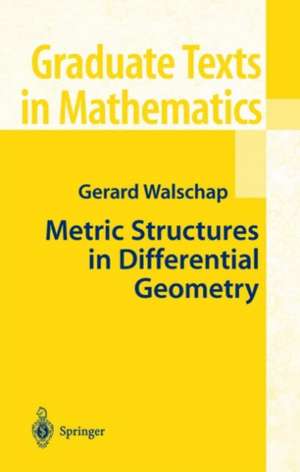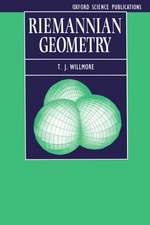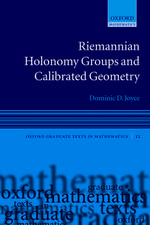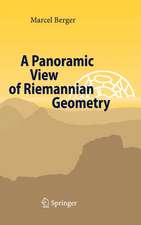Metric Structures in Differential Geometry: Graduate Texts in Mathematics, cartea 224
Autor Gerard Walschapen Limba Engleză Hardback – 18 mar 2004
| Toate formatele și edițiile | Preț | Express |
|---|---|---|
| Paperback (1) | 484.47 lei 43-57 zile | |
| Springer – 29 noi 2010 | 484.47 lei 43-57 zile | |
| Hardback (1) | 587.53 lei 43-57 zile | |
| Springer – 18 mar 2004 | 587.53 lei 43-57 zile |
Din seria Graduate Texts in Mathematics
- 17%
 Preț: 528.68 lei
Preț: 528.68 lei -
 Preț: 402.89 lei
Preț: 402.89 lei -
 Preț: 383.86 lei
Preț: 383.86 lei - 17%
 Preț: 366.57 lei
Preț: 366.57 lei - 17%
 Preț: 398.97 lei
Preț: 398.97 lei -
 Preț: 355.83 lei
Preț: 355.83 lei -
 Preț: 412.25 lei
Preț: 412.25 lei -
 Preț: 404.48 lei
Preț: 404.48 lei -
 Preț: 289.88 lei
Preț: 289.88 lei - 17%
 Preț: 365.80 lei
Preț: 365.80 lei - 17%
 Preț: 359.45 lei
Preț: 359.45 lei - 15%
 Preț: 488.70 lei
Preț: 488.70 lei - 13%
 Preț: 357.76 lei
Preț: 357.76 lei -
 Preț: 407.88 lei
Preț: 407.88 lei - 13%
 Preț: 352.49 lei
Preț: 352.49 lei - 13%
 Preț: 358.86 lei
Preț: 358.86 lei - 13%
 Preț: 393.48 lei
Preț: 393.48 lei - 11%
 Preț: 351.00 lei
Preț: 351.00 lei - 17%
 Preț: 359.58 lei
Preț: 359.58 lei -
 Preț: 350.46 lei
Preț: 350.46 lei - 8%
 Preț: 567.37 lei
Preț: 567.37 lei -
 Preț: 399.74 lei
Preț: 399.74 lei -
 Preț: 498.91 lei
Preț: 498.91 lei - 20%
 Preț: 571.26 lei
Preț: 571.26 lei - 15%
 Preț: 548.81 lei
Preț: 548.81 lei -
 Preț: 498.69 lei
Preț: 498.69 lei - 15%
 Preț: 354.39 lei
Preț: 354.39 lei -
 Preț: 313.11 lei
Preț: 313.11 lei - 13%
 Preț: 427.40 lei
Preț: 427.40 lei - 17%
 Preț: 363.60 lei
Preț: 363.60 lei -
 Preț: 340.19 lei
Preț: 340.19 lei - 17%
 Preț: 364.47 lei
Preț: 364.47 lei - 17%
 Preț: 366.47 lei
Preț: 366.47 lei - 17%
 Preț: 366.07 lei
Preț: 366.07 lei -
 Preț: 247.59 lei
Preț: 247.59 lei - 17%
 Preț: 367.70 lei
Preț: 367.70 lei - 13%
 Preț: 356.80 lei
Preț: 356.80 lei - 17%
 Preț: 398.78 lei
Preț: 398.78 lei - 17%
 Preț: 398.51 lei
Preț: 398.51 lei - 17%
 Preț: 496.65 lei
Preț: 496.65 lei - 13%
 Preț: 361.80 lei
Preț: 361.80 lei - 15%
 Preț: 482.97 lei
Preț: 482.97 lei -
 Preț: 402.02 lei
Preț: 402.02 lei - 17%
 Preț: 366.57 lei
Preț: 366.57 lei - 20%
 Preț: 449.74 lei
Preț: 449.74 lei -
 Preț: 380.35 lei
Preț: 380.35 lei -
 Preț: 364.80 lei
Preț: 364.80 lei
Preț: 587.53 lei
Preț vechi: 691.20 lei
-15% Nou
Puncte Express: 881
Preț estimativ în valută:
112.46€ • 122.20$ • 94.53£
112.46€ • 122.20$ • 94.53£
Carte tipărită la comandă
Livrare economică 21 aprilie-05 mai
Preluare comenzi: 021 569.72.76
Specificații
ISBN-13: 9780387204307
ISBN-10: 038720430X
Pagini: 236
Ilustrații: VIII, 229 p. 7 illus.
Dimensiuni: 152 x 229 x 18 mm
Greutate: 0.52 kg
Ediția:2004
Editura: Springer
Colecția Springer
Seria Graduate Texts in Mathematics
Locul publicării:New York, NY, United States
ISBN-10: 038720430X
Pagini: 236
Ilustrații: VIII, 229 p. 7 illus.
Dimensiuni: 152 x 229 x 18 mm
Greutate: 0.52 kg
Ediția:2004
Editura: Springer
Colecția Springer
Seria Graduate Texts in Mathematics
Locul publicării:New York, NY, United States
Public țintă
GraduateCuprins
1. Differentiable Manifolds.- 1. Basic Definitions.- 2. Differentiable Maps.- 3. Tangent Vectors.- 4. The Derivative.- 5. The Inverse and Implicit Function Theorems.- 6. Submanifolds.- 7. Vector Fields.- 8. The Lie Bracket.- 9. Distributions and Frobenius Theorem.- 10. Multilinear Algebra and Tensors.- 11. Tensor Fields and Differential Forms.- 12. Integration on Chains.- 13. The Local Version of Stokes’ Theorem.- 14. Orientation and the Global Version of Stokes’ Theorem.- 15. Some Applications of Stokes’ Theorem.- 2. Fiber Bundles.- 1. Basic Definitions and Examples.- 2. Principal and Associated Bundles.- 3. The Tangent Bundle of Sn.- 4. Cross-Sections of Bundles.- 5. Pullback and Normal Bundles.- 6. Fibrations and the Homotopy Lifting/Covering Properties.- 7. Grassmannians and Universal Bundles.- 3. Homotopy Groups and Bundles Over Spheres.- 1. Differentiable Approximations.- 2. Homotopy Groups.- 3. The Homotopy Sequence of a Fibration.- 4. Bundles Over Spheres.- 5. The Vector Bundles Over Low-Dimensional Spheres.- 1. Connections on Vector Bundles.- 4. Connections and Curvature.- 2. Covariant Derivatives.- 3. The Curvature Tensor of a Connection.- 4. Connections on Manifolds.- 5. Connections on Principal Bundles.- 5. Metric Structures.- 1. Euclidean Bundles and Riemannian Manifolds.- 2. Riemannian Connections.- 3. Curvature Quantifiers.- 4. Isometric Immersions.- 5. Riemannian Submersions.- 6. The Gauss Lemma.- 7. Length-Minimizing Properties of Geodesics.- 8. First and Second Variation of Arc-Length.- 9. Curvature and Topology.- 10. Actions of Compact Lie Groups.- 6. Characteristic Classes.- 1. The Weil Homomorphism.- 2. Pontrjagin Classes.- 3. The Euler Class.- 4. The Whitney Sum Formula for Pontrjagin and Euler Classes.- 5. Some Examples.- 6. The Unit SphereBundle and the Euler Class.- 7. The Generalized Gauss-Bonnet Theorem.- 8. Complex and Symplectic Vector Spaces.- 9. Chern Classes.
Recenzii
From the reviews:
"The book gives an introduction to the basic theory of differentiable manifolds and fiber bundles … The book is well written. The presentation is clear, detailed and essentially self-contained. This book is suitable for senior undergraduate and graduate students. It can be used for a course on manifolds and bundles, or a course in differential geometry." (M. Burkhardt, Zeitschrift für Analysis und ihre Anwendungen, 1, 2005)
"This text is an introduction to the theory of differentiable manifolds and fiber bundles … provides a comprehensive overview of differentiable manifolds … concepts are illustrated in detail for bundles over spheres … This book can be used for a one-semester course on manifolds or bundles, or a two-semester course in differential geometry." (L'enseignement mathématique, 50:1-2, 2004)
"This book is based on the author’s graduate-level lecture notes. … One of the strengths of this book is the fact that the author manages in a 220-page volume to cover important themes in Riemannian geometry and fiber bundles. … The book contains some nice examples … . The topics are well-closed and the content is well-organized. … This clearly written book is an excellent source for teaching a course in differential geometry … . It is a worthwhile addition to any mathematical library." (Stere Ianus, Zentralblatt MATH, Vol. 1083, 2006)
"This text should be an elementary introduction to differential geometry. … The style is rather concise and many facts are shifted to 165 nontrivial exercises. The book is very well written and can be recommended to those who want to learn the topic quickly and actively." (EMS Newsletter, June, 2005)
"This book is a carefully written text for an introductory graduate course on differentiable manifolds, fiber bundles and Riemannian geometry. … This book is a thorough and insightful introduction to modern differentialgeometry with many interesting examples and exercises that illustrate key concepts effectively; it is highly recommended by the reviewer." (Thomas E. Cecil, Mathematical Reviews, Issue 2006 e)
"In every mathematical library a number of introductory books to differential geometry can be found. They are all different in some aspect, but – at the same time – none presents all the concepts equally successfully to all the readers. So there is allways a need for new introductory books, and Walschap’s book is a good one of these. … The series of definitions, concepts and theories are punctuated by examples, remarks. Each section ends with exercises." (Árpád Kurusa, Acta Scientiarum Mathematicarum, Vol. 73, 2007)
"The book gives an introduction to the basic theory of differentiable manifolds and fiber bundles … The book is well written. The presentation is clear, detailed and essentially self-contained. This book is suitable for senior undergraduate and graduate students. It can be used for a course on manifolds and bundles, or a course in differential geometry." (M. Burkhardt, Zeitschrift für Analysis und ihre Anwendungen, 1, 2005)
"This text is an introduction to the theory of differentiable manifolds and fiber bundles … provides a comprehensive overview of differentiable manifolds … concepts are illustrated in detail for bundles over spheres … This book can be used for a one-semester course on manifolds or bundles, or a two-semester course in differential geometry." (L'enseignement mathématique, 50:1-2, 2004)
"This book is based on the author’s graduate-level lecture notes. … One of the strengths of this book is the fact that the author manages in a 220-page volume to cover important themes in Riemannian geometry and fiber bundles. … The book contains some nice examples … . The topics are well-closed and the content is well-organized. … This clearly written book is an excellent source for teaching a course in differential geometry … . It is a worthwhile addition to any mathematical library." (Stere Ianus, Zentralblatt MATH, Vol. 1083, 2006)
"This text should be an elementary introduction to differential geometry. … The style is rather concise and many facts are shifted to 165 nontrivial exercises. The book is very well written and can be recommended to those who want to learn the topic quickly and actively." (EMS Newsletter, June, 2005)
"This book is a carefully written text for an introductory graduate course on differentiable manifolds, fiber bundles and Riemannian geometry. … This book is a thorough and insightful introduction to modern differentialgeometry with many interesting examples and exercises that illustrate key concepts effectively; it is highly recommended by the reviewer." (Thomas E. Cecil, Mathematical Reviews, Issue 2006 e)
"In every mathematical library a number of introductory books to differential geometry can be found. They are all different in some aspect, but – at the same time – none presents all the concepts equally successfully to all the readers. So there is allways a need for new introductory books, and Walschap’s book is a good one of these. … The series of definitions, concepts and theories are punctuated by examples, remarks. Each section ends with exercises." (Árpád Kurusa, Acta Scientiarum Mathematicarum, Vol. 73, 2007)
Textul de pe ultima copertă
This text is an introduction to the theory of differentiable manifolds and fiber bundles. The only requisites are a solid background in calculus and linear algebra, together with some basic point-set topology. The first chapter provides a comprehensive overview of differentiable manifolds. The following two chapters are devoted to fiber bundles and homotopy theory of fibrations. Vector bundles have been emphasized, although principal bundles are also discussed in detail. The last three chapters study bundles from the point of view of metric differential geometry: Euclidean bundles, Riemannian connections, curvature, and Chern-Weil theory are discussed, including the Pontrjagin, Euler, and Chern characteristic classes of a vector bundle. These concepts are illustrated in detail for bundles over spheres. Chapter 5, with its focus on the tangent bundle, also serves as a basic introduction to Riemannian geometry in the large. This book can be used for a one-semester course on manifolds or bundles, or a two-semester course in differential geometry.
Gerard Walschap is Professor of Mathematics at the University of Oklahoma where he developed this book for a series of graduate courses he has taught over the past few years.
Gerard Walschap is Professor of Mathematics at the University of Oklahoma where he developed this book for a series of graduate courses he has taught over the past few years.
Caracteristici
Includes supplementary material: sn.pub/extras


















